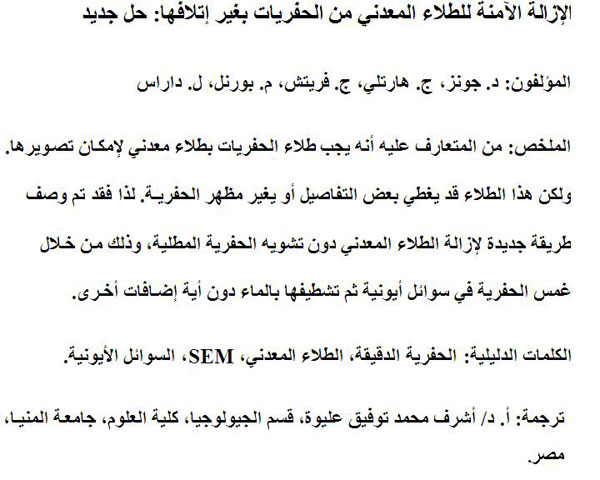Non-destructive, safe removal of conductive metal coatings from fossils: a new solution
Plain Language Abstract
Scanning electron microscopy is an important technique for making images in the sciences and often requires that the specimens to be imaged are coated with a thin layer of metal, such as gold, platinum or silver. However, the application of such metal coatings changes the appearance of specimens and can obscure important features, and thus may be undesirable, or even prohibited by those who look after the specimens. We describe a harmless, straightforward and inexpensive technique for removing gold coatings for specimens. The method involves immersing samples in liquids that react only with the metal coating. No further handling is needed, no poisonous substances are used in the process and the liquids can be tailored to remove other metal coatings.
Resumen en Español
Una nueva solución para la eliminación segura y no destructiva de recubrimientos de metales conductores en los fósiles
La microscopía electrónica de barrido y otras técnicas de generación de imágenes requieren habitualmente que los ejemplares analizados sean recubiertos por un metal conductor tal como oro, oro-paladio, platino o plata. Sin embargo, la aplicación de recubrimientos metálicos cambia la apariencia de los ejemplares y puede ocultar características importantes, lo que la convierte en un método no recomendable o incluso prohibido por instituciones y conservadores. En este artículo describimos una técnica inocua, sencilla y económica para eliminar el oro. El método consiste en la inmersión de las muestras en líquidos iónicos y su posterior aclarado con agua. No se necesitan más tratamientos ni se utilizan compuestos tóxicos en el proceso, y los líquidos pueden adaptarse para eliminar otros recubrimientos metálicos sin que se vea afectado el adhesivo usado para fijar el ejemplar en el soporte.
PALABRAS CLAVE: microfósil; recubrimiento metálico; SEM; líquidos iónicos
Traducción: Miguel Company
Résumé en Français
Nettoyage non destructif des revêtements métalliques conductif sur les fossiles: une nouvelle solution.
La microscopie électronique à balayage ainsi que d'autres techniques d'imagerie demandent souvent que les spécimens soit enduits d'un métal conductif, comme l'or, l'or-palladium, le platine ou l'argent. Cependant l'enduction des spécimens change leur apparence et peut cacher des caractères important. De fait elle est parfois non désirée voire même interdite par les conservateurs ou les institutions. Nous présentons une technique simple, peu onéreuse et non-destructrice pour enelver l'or. Cette méthode demande d'immerger les échantillons dans des liquides ioniques et de les rincer à l'eau. Aucune autre intervention n'est nécessaire, aucun composant dangereux n'est utilisé dans ce procédé et les liquides peuvent être modifiés pour enlever d'autres types d'enductions métalliques sans affecter l'adhésif utilisé pour maintenir le spécimen sur son substrat.
Mots-cléfs: microfossile, enduction métallique, SEM, liquides ioniques.
Translator: Loïc Costeur
Deutsche Zusammenfassung
Zerstörungsfreies, sicheres Entfernen von leitenden Metallüberzügen bei Fossilien: Eine neue Lösung
Rasterelektronenmikroskopie und andere Abbildungstechniken setzen normalerweise voraus, dass die abzubildenden Stücke mit einem leitenden Metall wie Gold, Gold-Palladium, Platin oder Silber beschichtet werden. Ein solcher Überzug ändert jedoch das Erscheinungsbild der Stücke, da auf diese Weise wichtige Merkmale verdeckt werden können. Daher ist eine Beschichtung nicht wünschenswert oder wird möglicherweise sogar von einigen Museen und Kuratoren verboten. Wir beschreiben eine harmlose, einfache und kostengünstige Technik, wie das Gold entfernt werden kann. Die Methode erfordert lediglich, die Proben in ionische Flüssigkeiten einzutauchen und mit Wasser abzuspülen. Es ist keine weitere Behandlung nötig, es werden keine giftigen Verbindungen benutzt und die Flüssigkeiten können auf die Entfernung anderer Metallschichten angepasst werden ohne sich auf das Klebemittel auszuwirken mit dem das Stück am Trägermaterial befestigt ist.
SCHLÜSSLWÖRTER: Mikrofossil; Metallüberzug, SEM; ionische Flüssigkeiten
Translators: Eva Gebauer and Anke Konietzka
Arabic

Translator: Ashraf M.T. Elewa
Polski Abstrakt
Niedestruktywne i bezpieczne usuwanie przewodzących powłok metalowych z skamieniałości: nowe rozwiązanie
Elektronowa mikroskopia skaningowa, a niektóre inne techniki obrazowania, często wymagają, by fotografowane okazy były pokryte metalem przewodzącym; np. złotem, złotem-palladem, platyną lub srebrem. Jednak zastosowanie powłok metalowych może być niepożądane, a nawet zabronione przez instytucje lub kuratorów, ponieważ zmienia wygląd okazów i może przesłaniać ważne cechy. W niniejszej pracy opisujemy nieszkodliwą, bezpośrednią i tanią technikę stosowalną w celu usuwania złota. Metoda polega na zanurzeniu próbki w cieczy jonowej i wypłukaniu w wodzie. Żadna dodatkowa manipulacja nie jest potrzebna, żadne trujące związki nie są w tym procesie wykorzystywane, a ciecze mogą być dostosowane do usunięcia innych powłok metalowych nie wpływając na spoiwo użyte do przymocowania próbki do podłoża.
Słowa kluczowe: mikroskamieniałość, nakładanie powłok metalowych, elektronowy mikroskop skaningowy, ciecze jonowe
Translators: Dawid Mazurek, Robert Bronowicz, and Daniel Madzia

